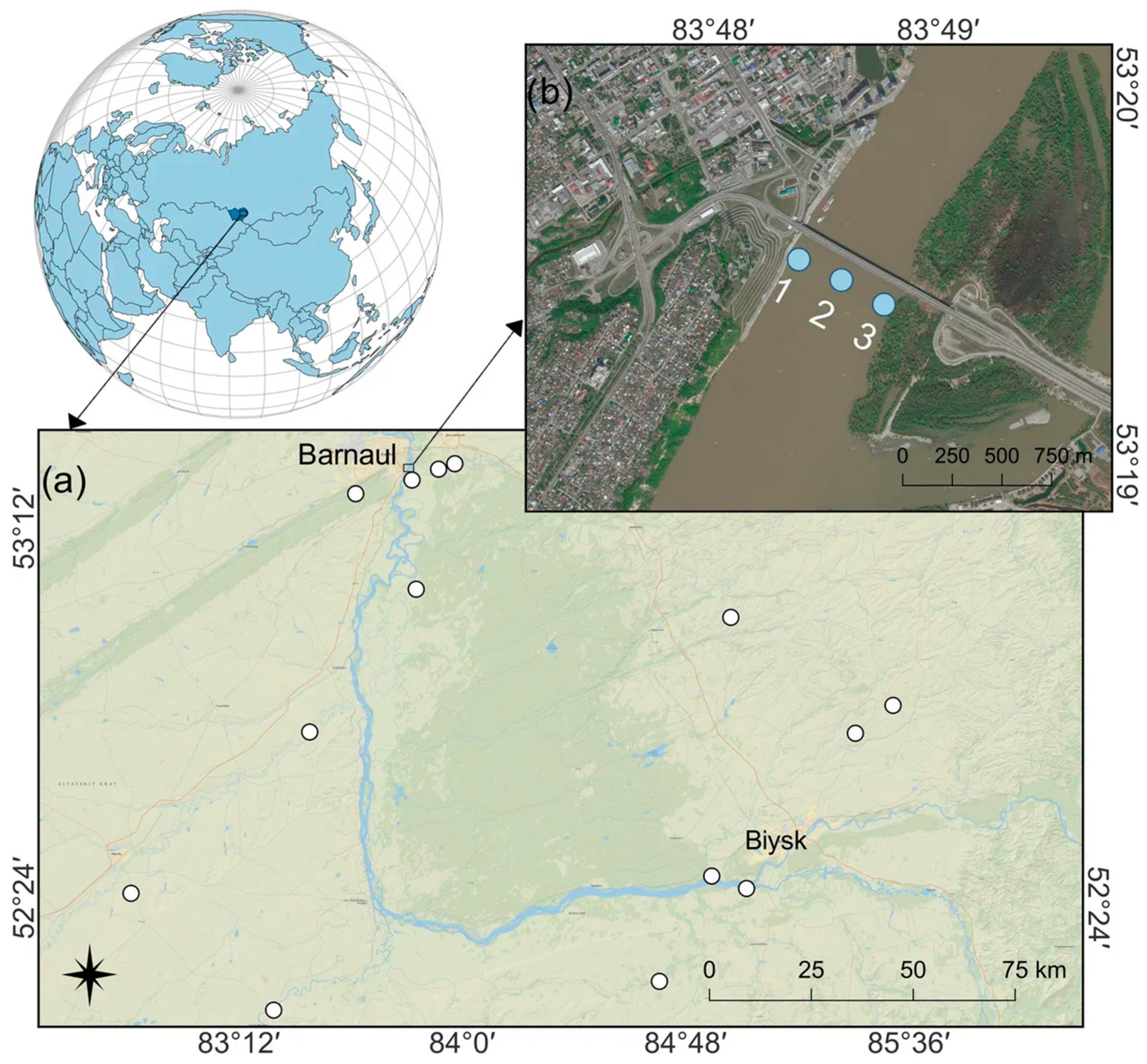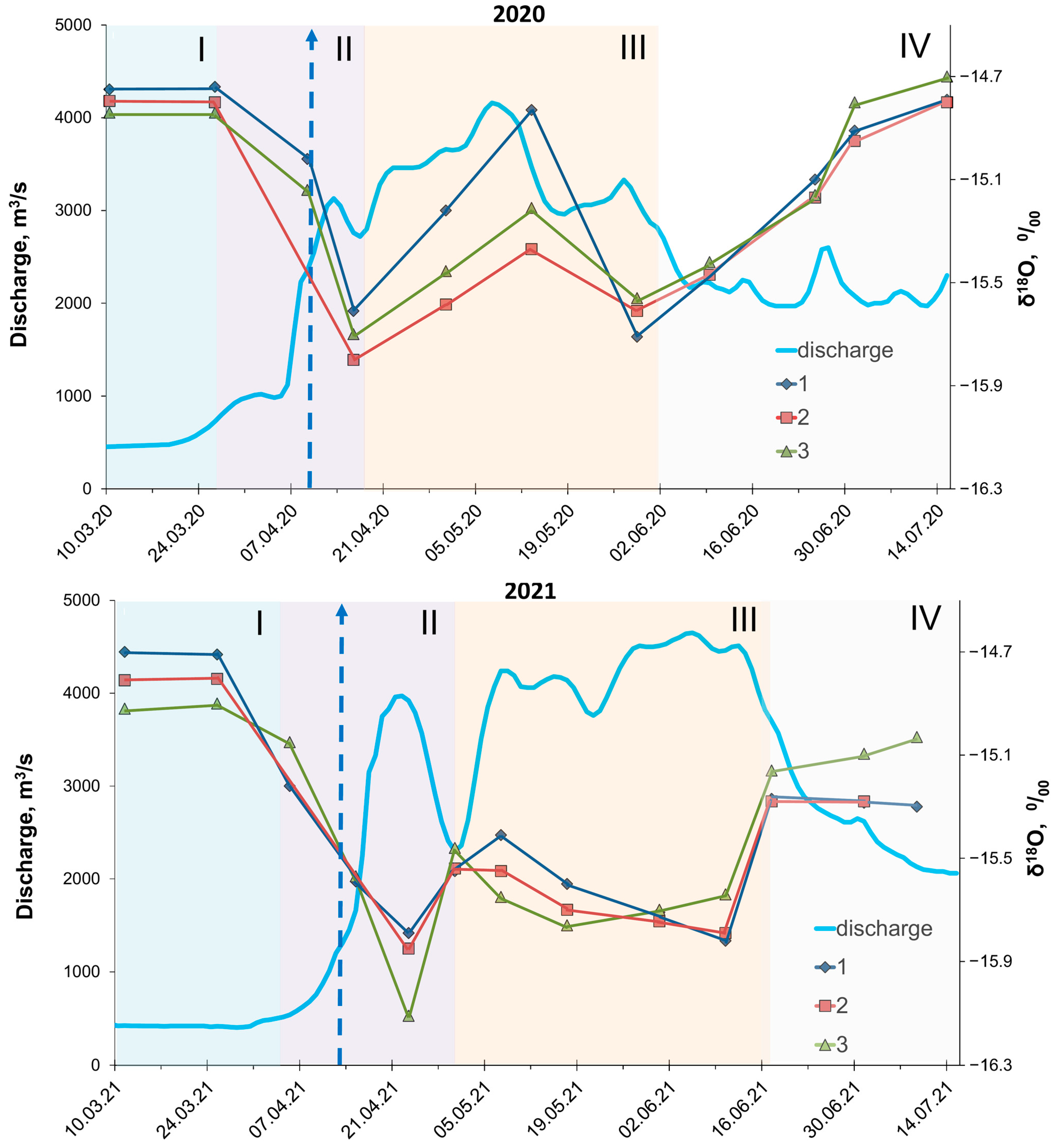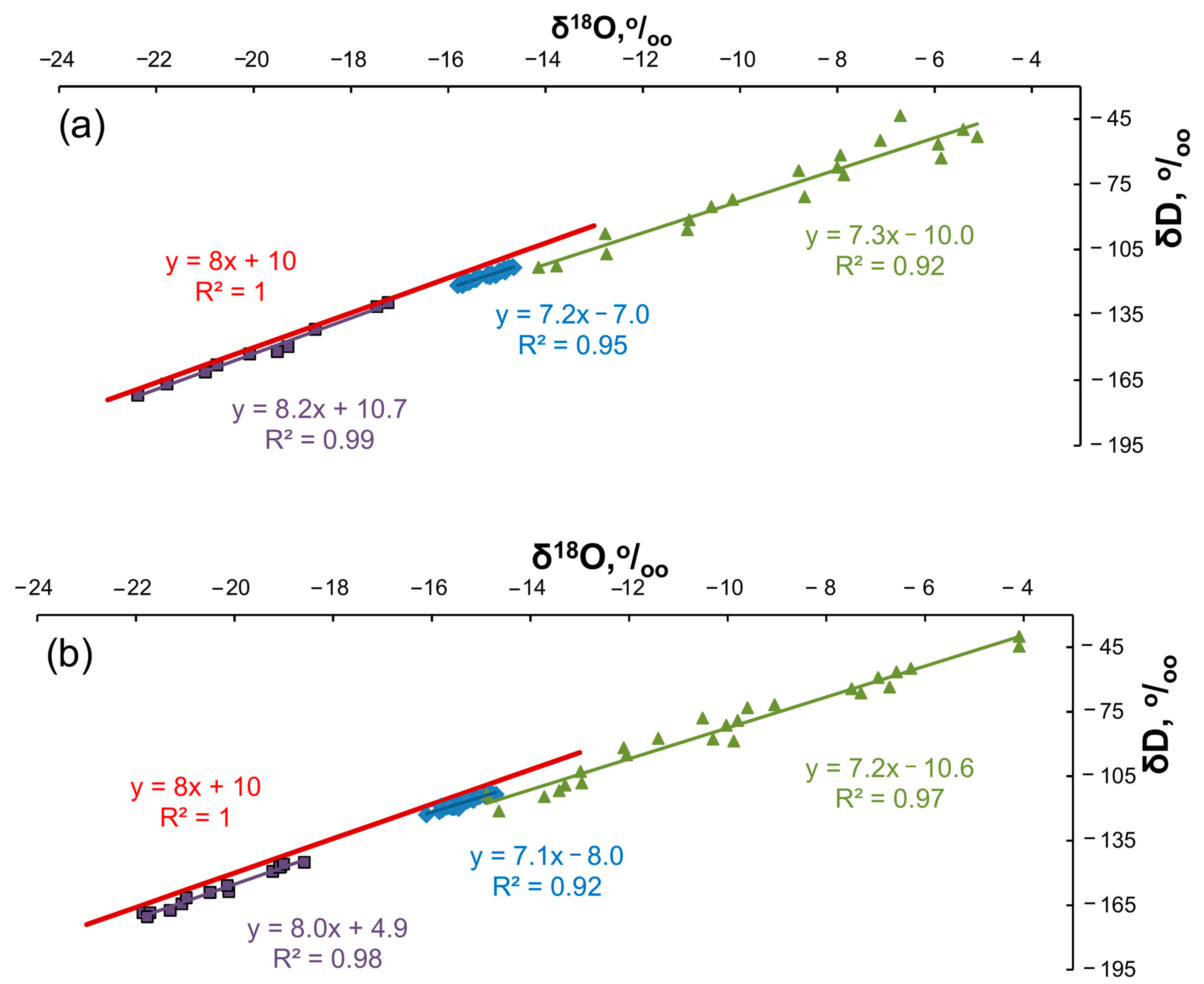Impact of Snowmelt Conditions on the Isotopic Composition of the Surface Waters of the Upper Ob River during the Flood Period
Abstract
1. Introduction
2. Materials and Methods
2.1. Study Area
2.2. Sampling
2.3. Analytical Methods
3. Results
4. Discussion
5. Conclusions
- The lightest isotopic composition of the Upper Ob River water occurred at the end of the first and the second flood phases due to the influx of melted snow from the flat catchment area (first phase), and then due to melted snow and glacial waters from the high mountains (second phase).
- In our opinion, a short-term weighting of the water isotope composition by 0.5–0.9‰ in terms of δ18O at the beginning of the second stage of the flood is attributed to the discharge of groundwater due to the expulsion of autumn moisture by snowmelt waters. During this period, the groundwater flow is a mixture of last year’s autumn rainfalls and the melted snow water of the current year.
- The main factors controlling the rate and volume of snowmelt water flow from the catchment area to the Upper Ob channel are the initial conditions of the snow cover formation (autumn moisture content and freezing of the soil in the catchment area at the beginning of winter). Therefore, monitoring these conditions will allow the prediction of the magnitude and features of the first phase of the flood.
- An assessment of the rain and snow contributions to the Upper Ob River runoff during the snowmelt period was carried out using the average values of the isotopic composition of the surface water, the precipitation-weighted mean of autumn rainfalls, and the depth-weighted mean of snow cover. The calculations showed that the contributions of the melted winter snow and autumn rainfalls from the previous year to the river water flow were, respectively, 52% and 48% in spring 2020 and 43% and 57% in spring 2021.
- The difference between the date of complete melting of the snow cover in the catchment area and the date of the maximum light isotopic composition of water in the outlet section was proposed for estimating the time for meltwater runoff from the catchment area to the outlet section. This substantiated approach allowed us to estimate the time for the melted snow runoff to reach the outlet section of the Upper Ob River, being 11 and 10 days in 2020 and 2021, respectively.
Author Contributions
Funding
Data Availability Statement
Acknowledgments
Conflicts of Interest
References
- Gat, J.R. Oxygen and hydrogen isotopes in the hydrologic cycle. Annu. Rev. Earth Planet. Sci. 1996, 24, 225–262. [Google Scholar] [CrossRef]
- Gibson, J.J.; Aggarwal, P.; Hogan, J.; Kendall, C.; Martinelli, L.A.; Stichler, W.; Rank, D.; Goni, I.; Choudhry, M.; Gat, J.; et al. Isotope studies in large river basins: A new global research focus. Eos. Trans. AGU 2002, 83, 613–617. [Google Scholar] [CrossRef]
- Kendall, C.; Doctor, D.H. Stable Isotope Applications in Hydrologic Studies. In Treatise on Geochemistry, 1st ed.; Turekian, K.K., Holland, H.D., Eds.; Elsevier: Amsterdam, The Netherlands, 2003; Volume 5, pp. 319–364. [Google Scholar]
- Gibson, J.J.; Birks, S.J.; Yi, Y.; Vitt, D.H. Runoff to boreal lakes linked to land cover, watershed morphology and permafrost thaw: A 9-year isotope mass balance assessment. Hydrol. Process. 2015, 29, 3848–3861. [Google Scholar] [CrossRef]
- Gibson, J.J.; Yi, Y.; Birks, S.J. Isotope-based partitioning of streamflow in the oil sands region, northern Alberta: Towards a monitoring strategy for assessing flow sources and water quality controls. J. Hydrol. Region. Stud. 2016, 5, 131–148. [Google Scholar] [CrossRef]
- Ala-aho, P.; Soulsby, C.; Pokrovsky, O.S.; Kirpotin, S.N.; Karlsson, J.; Serikova, S.; Vorobyev, S.N.; Manasypov, R.M.; Loiko, S.; Tetzlaff, D. Using stable isotopes to assess surface water source dynamics and hydrological connectivity in a high-latitude wetland and permafrost influenced landscape. J. Hydrol. 2018, 556, 279–293. [Google Scholar] [CrossRef]
- Beria, H.; Larsen, J.R.; Ceperley, N.; Michelon, A.; Vennemann, T.; Schaefli, B. Understanding snow hydrological processes through the lens of stable water isotopes. Wiley Interdiscip. Rev. Water 2018, 5, e1311. [Google Scholar] [CrossRef]
- Bowen, G.J.; Cai, Z.; Fiorella, R.P.; Putman, A.L. Isotopes in the Water Cycle: Regional-to Global-Scale Patterns and Applications. Annu. Rev. Earth Planet. Sci. 2019, 47, 453–479. [Google Scholar] [CrossRef]
- Nan, Y.; Tian, F.; Hu, H.; Wang, L.; Zhao, S. Stable Isotope Composition of River Waters across the World. Water 2019, 11, 1760. [Google Scholar] [CrossRef]
- Lucianetti, G.; Penna, D.; Mastrorillo, L.; Mazza, R. The Role of Snowmelt on the Spatio-Temporal Variability of Spring Recharge in a Dolomitic Mountain Group, Italian Alps. Water 2020, 12, 2256. [Google Scholar] [CrossRef]
- Earman, S.; Campbell, A.R.; Phillips, F.M.; Newman, B.D. Isotopic exchange between snow and atmospheric water vapor: Estimation of the snowmelt component of groundwater recharge in the southwestern United States. J. Geophys. Res-Atmos. 2006, 111, 1–18. [Google Scholar] [CrossRef]
- Ala-aho, P.; Welker, J.M.; Bailey, H.; Hojlund Pedersen, S.; Kopec, B.; Klein, E.; Mellat, M.; Mustonen, K.-R.; Noor, K.; Marttila, H. Arctic Snow Isotope Hydrology: A Comparative Snow-Water Vapor Study. Atmosphere 2021, 12, 150. [Google Scholar] [CrossRef]
- Feng, M.; Zhang, W.; Zhang, S.; Sun, Z.; Li, Y.; Huan, Y.; Wang, W.; Qi, P.; Zou, Y.; Jiang, M. The role of snowmelt discharge to runoff of an alpine watershed: Evidence from water stable isotopes. J. Hydrol. 2022, 604, 127209. [Google Scholar] [CrossRef]
- Meng, Y.; Liu, G.; Li, M. Tracing the Sources and Processes of Groundwater in an Alpine Glacierized Region in Southwest China: Evidence from Environmental Isotopes. Water 2015, 7, 2673–2690. [Google Scholar] [CrossRef]
- Živković, K.; Radulović, M.; Lojen, S.; Pucarević, M. Overview of the Chemical and Isotopic Investigations of the Mareza Springs and the Zeta River in Montenegro. Water 2020, 12, 957. [Google Scholar] [CrossRef]
- Tang, S.; Qin, D.; Ren, J.; Kang, J.; Li, Z. Structure, salinity and isotopic composition of multi-year landfast sea ice in Nella Fjord, Antarctica. Cold Reg. Sci. Technol. 2007, 49, 170–177. [Google Scholar] [CrossRef]
- Jasechko, S.; Gibson, J.J.; Edwards, T.W.D. Stable isotope mass balance of the Laurentian Great Lakes. J. Great Lakes Res. 2014, 40, 336–346. [Google Scholar] [CrossRef]
- Gudkov, A.V.; Tolstikhin, I.N.; Tokarev, I.V. The formation and balance of the atmospheric precipitations, surface water, and groundwater on the southern slopes of the khibiny massif (based on data on the isotopic composition of oxygen and hydrogen). Water Resour. 2021, 48, 124–132. [Google Scholar] [CrossRef]
- Penna, D.; Meerveld, H.J.; Zuecco, G.; Fontana, G.D.; Borga, M. Hydrological response of an Alpine catchment to rainfall and snowmelt events. J. Hydrol. 2016, 537, 382–397. [Google Scholar] [CrossRef]
- Kendall, C.; Coplen, T.B. Distribution of oxygen-18 and deuterium in river waters across the United States. Hydrol. Process. 2001, 15, 1363–1393. [Google Scholar] [CrossRef]
- Ogrinc, N.; Kanduc, T.; Stichler, W.; Vreca, P. Spatial and seasonal variations in δ18O and δD values in the River Sava in Slovenia. J. Hydrol. 2008, 359, 303–312. [Google Scholar] [CrossRef]
- Koeniger, P.; Leibundgut, C.; Stichler, W. Spatial and temporal characterisation of stable isotopes in river water as indicators of groundwater contribution and confirmation of modelling results; a study of the Weser River, Germany. Isot. Environ. Health Stud. 2009, 45, 289–302. [Google Scholar] [CrossRef] [PubMed]
- Gibson, J.J.; Edwards, T.W.D. Regional water balance trends and evaporation-transpiration partitioning from a stable isotope survey of lakes in northern Canada. Glob. Biogeochem. Cycles 2002, 16, 1026. [Google Scholar] [CrossRef]
- Wang, X.; Zhang, X.; Zhang, W.; Zhang, X.; Luo, Z. Comparison on Spatial Distribution of Hydrogen and Oxygen Stable Isotope GCM Simulation in Global Precipitation. Adv. Earth Sci. 2017, 32, 983–995. [Google Scholar]
- He, Z.; Unger-Shayesteh, K.; Vorogushyn, S.; Weise, S.M.; Kalashnikova, O.; Gafurov, A.; Merz, B. Constraining hydrological model parameters using water isotopic compositions in a glacierized basin, Central Asia. J. Hydrol. 2019, 571, 332–348. [Google Scholar] [CrossRef]
- Pu, T.; Wang, K.; Kong, Y.; Shi, X.; Kang, S.; Huang, Y.; He, Y.; Wang, S.; Lee, J.; Cuntz, M. Observing and Modeling the Isotopic Evolution of Snow Meltwater on the Southeastern Tibetan Plateau. Water Resour. Res. 2020, 56, e2019WR026423. [Google Scholar] [CrossRef]
- Nan, Y.; He, Z.; Tian, F.; Wei, Z.; Tian, L. Can we use precipitation isotope outputs of Isotopic General Circulation Models to 2 improve hydrological modeling in large mountainous catchments on the Tibetan Plateau? Hydrol. Earth. Syst. Sci. 2021, 25, 6151–6172. [Google Scholar] [CrossRef]
- Chernyaev, A.M. Water of Russia. River Basins; FSUE: Moscow, Russia, 2002; p. 572. (In Russian) [Google Scholar]
- Borodaev, V.D.; Bulatov, V.I.; Vedukhina, V.G.; Vorobyov, K.V.; Ershova, I.N.; Kalyuzhnaya, T.V.; Kontev, A.V.; Krupochkin, E.P.; Kurepina, N.Y.; Mardasova, E.V.; et al. Barnaul: Scientific Reference Atlas, 2nd ed.; PO Inzhgeodeziya: Novosibirsk, Russia, 2007; p. 112. (In Russian) [Google Scholar]
- Kharlamova, N.F. Climate and Seasonal Rhythmics of Barnaul Nature: Monograph; AltSU Publishing House: Barnaul, Russia, 2013; p. 132. (In Russian) [Google Scholar]
- Gefke, I.V.; Aleshina, N.I. Physical and geographical characteristics Upper Obi basin. Int. J. Humanit. Nat. Sci. 2019, 11–12, 61–63. (In Russian) [Google Scholar] [CrossRef]
- Marusin, K.V.; Dyachenko, A.V.; Kolomeytsev, A.A.; Wagner, A.A. Modern morphodynamics and history of evolution of Ob River at Barnaul City. Bull. AB RGS 2019, 55, 82–92. (In Russian) [Google Scholar]
- Shvetsov, A.Y.; Gorlov, E.A. Natural Conditions of Barnaul; Publishing House “New Format”: Barnaul, Russia, 2020; p. 178. (In Russian) [Google Scholar]
- Kurkina, T.V. On the State and Environmental Protection of the City District—The City of Barnaul in the Altai Territory in 2020; Publishing House “Skywalker”: Barnaul, Russia, 2021; p. 191. (In Russian) [Google Scholar]
- Andreeva, I.V.; Rotanova, I.N.; Tsymbaley, Y.M. Design of water protection zones of rivers with non-linear channels (for example, a section of the Ob River in the Cities of Barnaul). Water Sect. Russ. Probl. Technol. Manag. 2012, 2, 4–16. (In Russian) [Google Scholar]
- Papina, T.S.; Eirikh, A.N.; Malygina, N.S.; Eyrikh, S.S.; Ostanin, O.V.; Yashina, T.V. Microelement and stable isotopic composition of snowpack in the Katunsky Biosphere Reserve (Altai Republic). Ice Snow 2018, 58, 41–55. [Google Scholar] [CrossRef]
- Papina, T.; Eirikh, A.; Noskova, T. Factors influencing changes of the initial stable water isotopes composition in the seasonal snowpack of the south of Western Siberia, Russia. Appl. Sci. 2022, 12, 625. [Google Scholar] [CrossRef]
- Craig, H. Isotopic variations in meteoric waters. Science 1961, 133, 1702–1703. [Google Scholar] [CrossRef] [PubMed]
- Dansgaard, W. Stable isotopes in precipitation. Tellus 1964, 16, 436–468. [Google Scholar] [CrossRef]
- Rozanski, K.; Aragufis-Aragufis, L.; Gonfiantini, R. Isotopic patterns in modern global precipitation. In Climate Change in Continental Isotopic Records; Swart, P.K., Lohmann, K.C., Mckenzie, J., Savin, S., Eds.; American Geophysical Union: Washington, DC, USA, 1993; Volume 78, pp. 1–36. [Google Scholar]
- Tian, L.; Yao, T.; MacClune, K.; White, J.W.C.; Schilla, A.; Vaughn, B.; Vachon, R.; Ichiyanagi, K. Stable isotopic variations in West China: A consideration of moisture sources. J. Geophys. Res. 2007, 112, D10112. [Google Scholar] [CrossRef]
- Automated Information System for State Monitoring of Water Bodies. Available online: https://gmvo.skniivh.ru// (accessed on 31 March 2023).
- Strelkovskiy, A.N. On the State and Environmental Protection in the Altai Territory in 2021; Publishing House “Print”: Izhevsk, Russia, 2022; p. 192. (In Russian) [Google Scholar]
- Strelkovskiy, A.N. On the State and Environmental Protection in the Altai Territory in 2020; Publishing House “Print”: Izhevsk, Russia, 2021; p. 200. (In Russian) [Google Scholar]
- Specialized Data Sets for Climate Research. Available online: http://aisori-m.meteo.ru/waisori/ (accessed on 31 March 2023).
- Galakhov, V.P.; Mardasova, E.V.; Lyutsiger, N.V.; Samoilova, S.Y. Influence of fall freezing on maximum levels of Charysh river basin. Bull. AB RGS 2018, 49, 54–57. (In Russian) [Google Scholar]



| δ18O, ‰ | δD, ‰ | d-Excess, ‰ | ||||
|---|---|---|---|---|---|---|
| 1 | 2 | 1 | 2 | 1 | 2 | |
| river water: | ||||||
| the entire period | −15.2 | −15.4 | −117.0 | −117.5 | 4.7 | 5.7 |
| the winter low-water | −14.8 | −15.0 | −113.8 | −113.9 | 4.9 | 4.6 |
| the first phase of the flood | −15.4 | −15.7 | −118.2 | −119.0 | 4.3 | 5.5 |
| the second phase of the flood | −15.4 | −15.6 | −119.2 | −119.1 | 5.1 | 6.7 |
| autumn precipitation (94/127 mm) 1 | −10.2 | −12.6 | −81.5 | −99.9 | −0.1 | −0.5 |
| snow cover (170/115 mm weq.) 2 | −20.3 | −19.8 | −157.8 | −151.3 | 4.7 | 7.2 |
| spring–summer precipitation 3: | ||||||
| the first phase of the flood (5/4 mm) | −8.6 | −5.0 | −60.3 | −44.0 | 8.5 | −3.9 |
| the second phase of the flood (38/45 mm) | −8.3 | −10.6 | −61.2 | −82.6 | 5.0 | 2.6 |
| 2019–2020 | 2020–2021 | Standard Average [34] | |
|---|---|---|---|
| The day of snow cover formation | 13.11.19 | 13.11.20 | 7–10.11 |
| Winter precipitation, mm | 170 | 115 | 139 |
| Snow depth at an air temperature <−25 °C for more than 3 days, cm | 20 | 10 | ⸻ |
| Maximum depth of the snowpack, cm | 72 | 52 | ⸻ |
| Climate spring (start of the active snowmelt) | 30.03.20 | 05.04.21 | 07.04 |
| End of the snowmelt | 09.04.20 | 13.04.21 | 10–15.04 |
| Average monthly temperature for the winter and spring seasons | |||
| November | −9 | −4.2 | −6.3 |
| December | −8.7 | −15.5 | −12.9 |
| January | −10.5 | −19.8 | −15.5 |
| February | −7.7 | −13.8 | −13.7 |
| March | −2.9 | −5.5 | −6.5 |
| April | 9.7 | 4.6 | 3.7 |
| May | 16.8 | 15.6 | 12.1 |
Disclaimer/Publisher’s Note: The statements, opinions and data contained in all publications are solely those of the individual author(s) and contributor(s) and not of MDPI and/or the editor(s). MDPI and/or the editor(s) disclaim responsibility for any injury to people or property resulting from any ideas, methods, instructions or products referred to in the content. |
© 2023 by the authors. Licensee MDPI, Basel, Switzerland. This article is an open access article distributed under the terms and conditions of the Creative Commons Attribution (CC BY) license (https://creativecommons.org/licenses/by/4.0/).
Share and Cite
Papina, T.; Eirikh, A.; Kotovshchikov, A.; Noskova, T. Impact of Snowmelt Conditions on the Isotopic Composition of the Surface Waters of the Upper Ob River during the Flood Period. Water 2023, 15, 2096. https://doi.org/10.3390/w15112096
Papina T, Eirikh A, Kotovshchikov A, Noskova T. Impact of Snowmelt Conditions on the Isotopic Composition of the Surface Waters of the Upper Ob River during the Flood Period. Water. 2023; 15(11):2096. https://doi.org/10.3390/w15112096
Chicago/Turabian StylePapina, Tatyana, Alla Eirikh, Anton Kotovshchikov, and Tatiana Noskova. 2023. "Impact of Snowmelt Conditions on the Isotopic Composition of the Surface Waters of the Upper Ob River during the Flood Period" Water 15, no. 11: 2096. https://doi.org/10.3390/w15112096
APA StylePapina, T., Eirikh, A., Kotovshchikov, A., & Noskova, T. (2023). Impact of Snowmelt Conditions on the Isotopic Composition of the Surface Waters of the Upper Ob River during the Flood Period. Water, 15(11), 2096. https://doi.org/10.3390/w15112096







